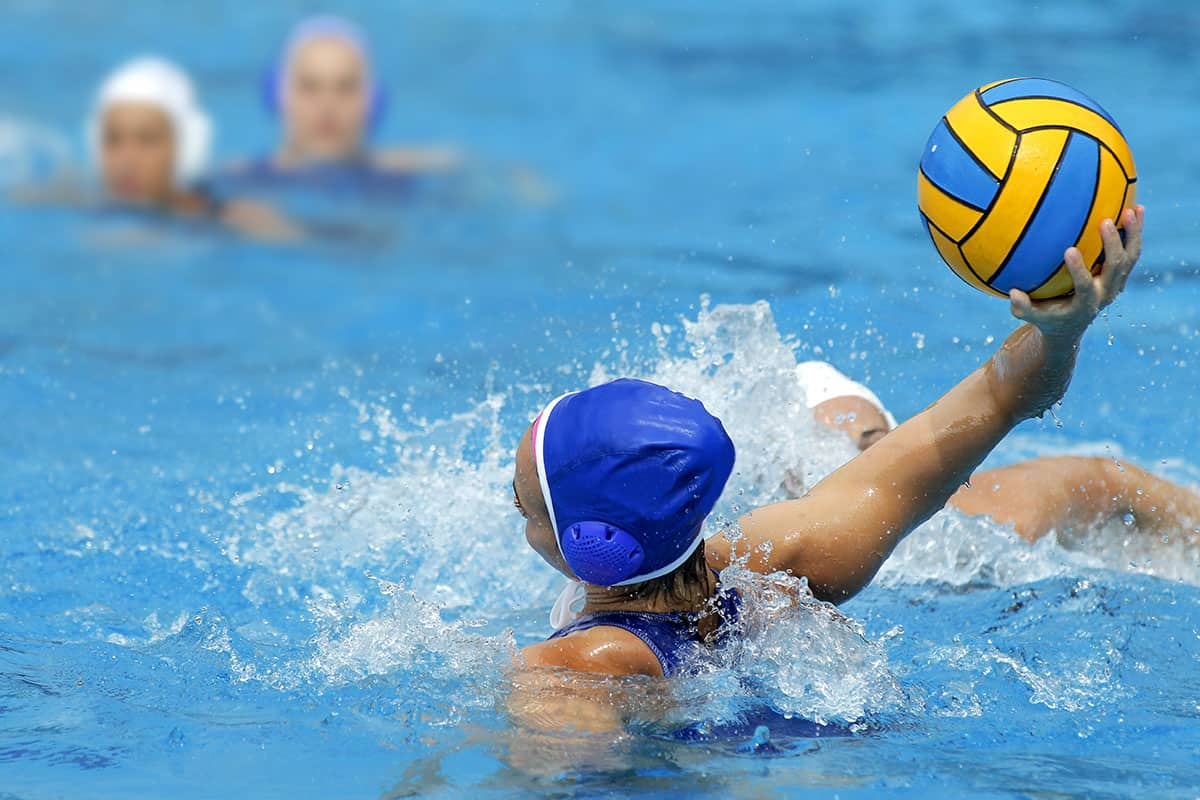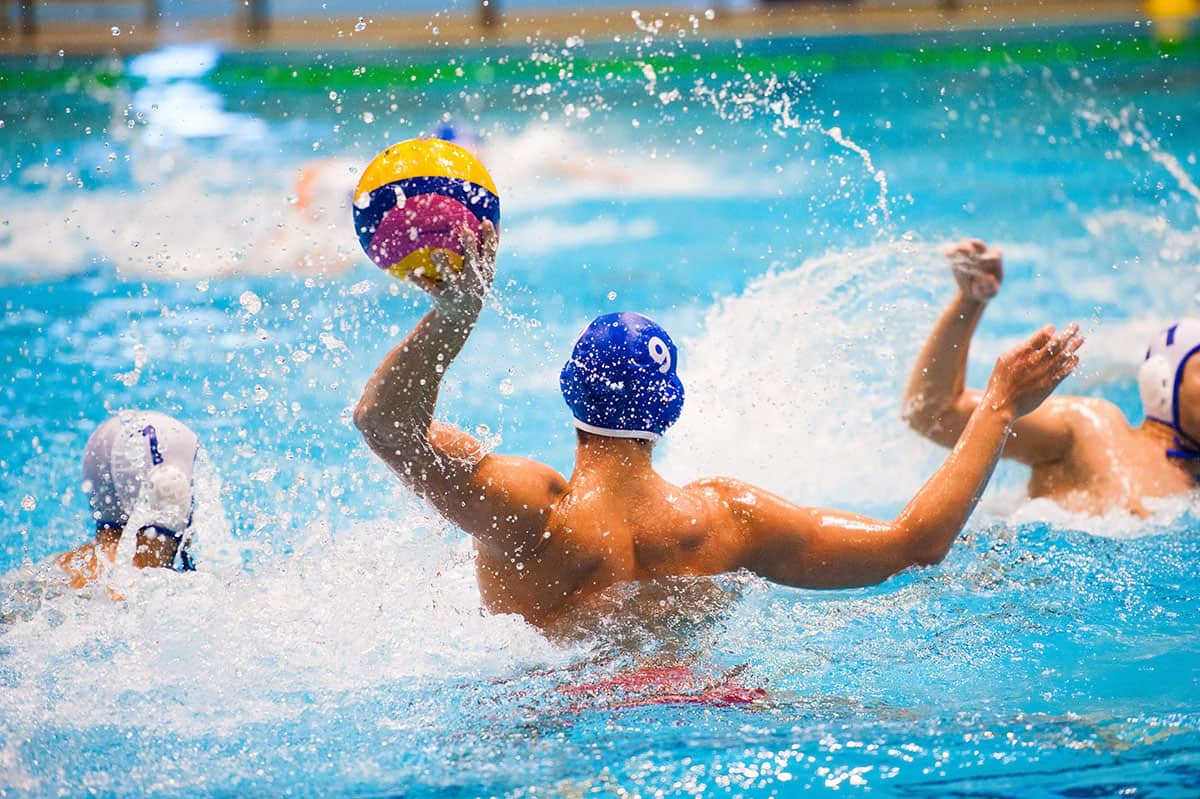In a sport that requires the shoulder flexibility of a pro baseball pitcher combined with the shoulder strength of a NFL linebacker, it’s no surprise that shoulder injuries abound. Here’s how they happen—and what can be done about it.
Water polo has the distinction of being one of the first Olympic team sports, debuting at the 1900 Paris Olympics. Originally played in rivers and lakes as an aquatic version of rugby, it is a physically demanding sport with rapid changes between high and low intensity intervals.
Water polo combines swimming, throwing, tackling, and blocking. Players must swim continuously in sprints up and down the pool while quickly changing directions as the ball changes teams. The game also requires players to grapple against opponents, stay upright by treading water, and shoot/pass the ball for four quarters of eight minutes each. If it sounds like a gruelling display of athleticism—it is!
Prevalence of injury
Water polo is an injury-ridden sport. A 2019 study analysed injuries of water polo players during four Summer Olympic Games and four Federation Internationale de Natation World Championships. After analysing 8904 player matches, they discovered a very high player injury rate of 14.1%. A newly published 2021 study put this possibly even higher, with an injury prevalence amongst Olympic-level players ranging from 9.7%– 19.4%.
Shoulder injuries are especially common in water polo athletes. A 2018 study reported shoulder injury rates varying from 24% – 51%. Interestingly, the study found that shoulder injuries were more likely to become chronic compared to all other reported injuries.
An 2017 original research study indicates that the rate of shoulder pathology may be even higher. The study included 42 water polo players from two clubs in the premier and second Italian league underwent ultrasound to identify and diagnose shoulder injuries. A whopping 90% of participants had shoulder pathology related to the activities of this sport . Some of these injuries were not yet symptomatic but could clearly be seen on ultrasound.

In a sport that requires the shoulder flexibility of a pro baseball pitcher combined with the shoulder strength of a NFL linebacker, it’s no surprise that shoulder injuries abound. Here’s how they happen—and what can be done about it.
Water polo has the distinction of being one of the first Olympic team sports, debuting at the 1900 Paris Olympics. Originally played in rivers and lakes as an aquatic version of rugby, it is a physically demanding sport with rapid changes between high and low intensity intervals.
Water polo combines swimming, throwing, tackling, and blocking. Players must swim continuously in sprints up and down the pool while quickly changing directions as the ball changes teams. The game also requires players to grapple against opponents, stay upright by treading water, and shoot/pass the ball for four quarters of eight minutes each. If it sounds like a gruelling display of athleticism—it is!
Prevalence of injury
Water polo is an injury-ridden sport. A 2019 study analysed injuries of water polo players during four Summer Olympic Games and four Federation Internationale de Natation World Championships. After analysing 8904 player matches, they discovered a very high player injury rate of 14.1%. A newly published 2021 study put this possibly even higher, with an injury prevalence amongst Olympic-level players ranging from 9.7%– 19.4%.
Shoulder injuries are especially common in water polo athletes. A 2018 study reported shoulder injury rates varying from 24% – 51%. Interestingly, the study found that shoulder injuries were more likely to become chronic compared to all other reported injuries.
An 2017 original research study indicates that the rate of shoulder pathology may be even higher. The study included 42 water polo players from two clubs in the premier and second Italian league underwent ultrasound to identify and diagnose shoulder injuries. A whopping 90% of participants had shoulder pathology related to the activities of this sport . Some of these injuries were not yet symptomatic but could clearly be seen on ultrasound.

The cause of shoulder injuries
There are several reasons why shoulder injuries abound in water polo. Biomechanical factors contributing to the significant and complex combinations of shoulder injuries include:
- head-up swimming
- overhead arm action
- a peculiar throwing movement
Also, because their feet cannot touch the bottom of the pool, muscles around the shoulder blade and upper back fatigue faster. Additionally, some players enter water polo as elite swimmers, which is often associated with highly mobile shoulders. Since high milage in the pool puts swimmers at risk of swimmer shoulder, or shoulder pain related to glenohumeral multidirectional hypermobility, this can further complicate shoulder health for water polo players.
Interestingly, a recent and comprehensive 2021 study found that training injuries seem to affect the shoulder area most. Therefore, water polo players should give special consideration to injury prevention during training, as discussed below.
Types of upper extremity injuries in water polo players
Many shoulder injuries related to water polo happen due to overuse and fatigue of the shoulder muscles due to repetitive swimming/throwing. Over time, motions of play cause wear and tear on the labrum (rim of the shoulder socket), and the rotator cuff as well as bicep tendons. Common injuries due to overuse include:
- tendinopathies of the long head of biceps and the rotator cuff muscles
- shoulder impingement
- labrum “wear and tear” or degeneration
- instability of the glenohumeral complex
- acromioclavicular joint degeneration
- thoracic outlet syndrome
Another reason for injury is due to to contact with other players, which can cause a sudden traumatic injury, such as:
- labrum tears
- shoulder dislocation
- rotator cuff tears
- humerus and scapula fractures
- clavicle fractures
Also, according to a 1997 study, imaging studies showed that posterosuperior impingement syndromes where there is an irritation or inflammation between the rotator cuff tendons and the scapula were common in players having shoulder pain. This condition alone may be a major cause of shoulder pain in water polo athletes, affecting their performance.
Overall, the variety of possible shoulder injuries can be challenging to diagnose because it can be difficult to decipher which injury is responsible for the onset of pain. To help solve this, recently some avid water polo researchers have recommended regular ultrasound imaging along with poolside ultrasound immediately after an injury to detect any new abnormalities.
Preventing injury
Unlike most sports that involve throwing, water polo players can’t rely on the ground reaction forces that transmits power through their legs and core muscles to maximize the strength and speed of the throwing action. Despite learning how to stabilize their core and generate some force from the movement in the water—using what is referred to as the egg-beater kick to elevate the body out of the water—the muscles of the shoulder must play a more significant role in generating the final effort needed to effectively throw and shoot the water polo balls. This movement creates a unique and significant strain on the shoulder muscles. In order to avoid injury, proper training and warm-ups/cool-downs are needed.
Training. Players should focus on full body strength, with special emphasis on dry-land shoulders and core strengthening. Stability, mobility, and flexibility is the name of the game. Athletes should start with low resistance and high repetitions before gradually transitioning into advanced exercises so that soft tissues and joints can build muscle memory with correct positioning. In addition, repetitive training in the water is necessary for the specific efforts of swimming and throwing the water polo ball, which cannot be completely matched with dry-land exercises. Competitive water polo is highly physically demanding, and often the competitions for the younger athletes occur in tournaments where they may play up to three games in a day.
Warming up and cooling down. Taking the time to warm up and cool down water polo-specific shoulder muscles increases range of motion, thereby reducing risk of injury. Warming up loosens rotator cuff muscles and improves shoulder mobility. Just like our baseball pitchers, the very act of competing can lead to temporary reduction in overall shoulder range of motion, which can predispose the athlete to a shoulder injury. Reestablishing normal motion after training or competition is important to prevent shoulder injuries.
*This article was originally published on Linkedin. Read it here.








